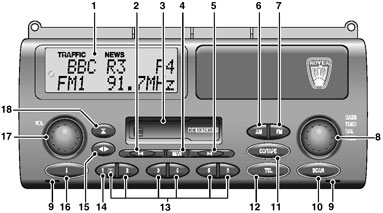|
In-Car Entertainment - Symphony
The Symphony unit was fitted as an option to the Classic and Club range, and like the other systems could be mated to a 6-CD unit as an option.
The Symphony ICE system comprises of the following parts:
- Alpine audio head unit
- Goodmans bass driver speaker fitted to each front and rear door trim panel
- Goodmans tweeter located in each front door cheater panel
- Goodmans tweeter located in each rear door trim panel
- AM/FM diversity rear screen aerial
- Aerial diversity amplifier located on the LH 'D' post
- Aerial filter unit located on the RH 'D' post
- Three steering wheel remote ICE switches
The audio head unit is located in the centre of the fascia. The unit is housed in a standard DIN case, although the
control panel fascia overlaps the case for its mounting in the fascia.
A 20 pin connector, made up from three separate connectors joined together, provides power supplies, K bus and
telephone and CD auto changer connections (if fitted). Two 8 pin connectors provide speaker, steering wheel remote
switches, power supplies and illumination connections. The unit is protected from electrical overload by a 10A fuse
located on the rear of the unit. A single co-axial socket provides for the connection of the aerial to the unit. A single
Intermediate Frequency (IF) socket provides an IF output of a nominal 10 MHz to the aerial amplifier. If the received
signal to the unit becomes weak, the IF output is changed. This is sensed by the aerial diversity amplifier which selects
another section of the rear screen aerial which gives an improved signal reception.
The Symphony system can operate with the ignition in the off position. After the ignition is switched off, pressing the
push on/off rotary volume control will cause the system to become active until the system is switched off again or a
20 minute timer has expired. After the 20 minute timer expires the system automatically switches off and can be
switched on for a further 20 minutes if required. A guide to the controls is given below: 
1 Liquid Crystal Display (LCD)
2 Radio tuning search down/tape rewind/tape
search backwards/CD track search backwards
(if fitted)
3 Cassette compartment
4 Radio manual tuning selector
5 Radio tuning search up/tape forward/tape
search backwards/CD track search forwards (if
fitted)
6 AM waveband selector button
7 FM waveband selector button
8 Audio selector button (bass/treble/balance/fade)
9 Security slots
10 Radio frequency scan button/tape scan button
11 CD/Tape mode selector
12 Telephone mode button (if cellular
communication system fitted)
13 Radio preset/CD disc selection (if fitted)
buttons
14 Tape Dolby (R) noise reduction
15 Tape reverse button
16 Traffic/news information button
17 Push on/off and rotary volume control
18 Cassette eject button
When the Symphony audio system is installed, it is connected to an overlay harness, which in turn is connected the main harness. When the system is fitted with an optional CD player at the factory, the Symphony system uses the overlay harness for the CD connection, which in turn is connected to the main harness. If the optional CD player is fitted by a dealer to a Symphony system without navigation, system is connected to an upgrade harness, which in turn is connected to the overlay and the main harness. If the optional CD player is fitted by a dealer to a Symphony system with navigation, the CD harness and connector is already provided as part of the overlay harness.
The audio head unit sends/receives K bus messages via the instrument pack for operation of the CD auto changer when fitted. A hardwired connection from the Light Switch Module (LSM) operates the control panel illumination when the side lamps or headlamps are switched on. The LSM illumination dimmer control adjusts the brightness of the
switch and LCD illumination.
|